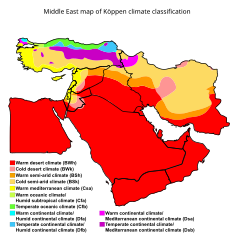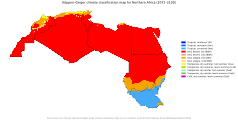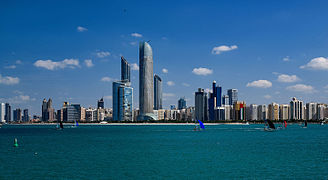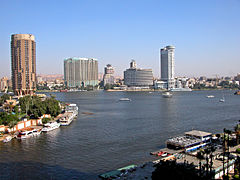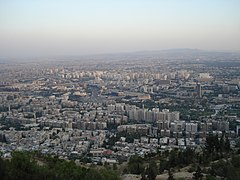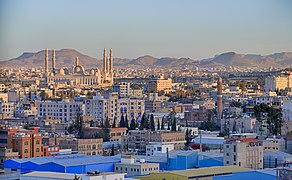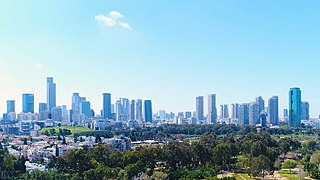Middle East
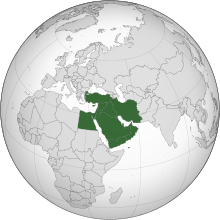 | |
| Area | 7,207,575 km2 (2,782,860 sq mi) |
|---|---|
| Population | 371 million (2010)[1] |
| Countries | UN members (16) UN observer (1) |
| Dependencies | |
| Languages | 60 languages
|
| Time zones | UTC+02:00, UTC+03:00, UTC+03:30, UTC+04:00, UTC+04:30 |
| Largest cities | |
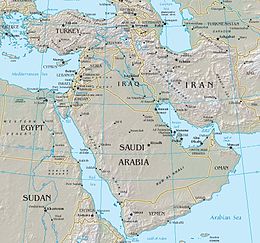

The Middle East (term originally coined in English [see § Terminology][note 1]) is a geopolitical region encompassing the Arabian Peninsula, the Levant, Turkey, Egypt, Iran, and Iraq. The term came into widespread usage as a replacement of the term Near East (as opposed to the Far East) beginning in the early 20th century. The term "Middle East" has led to some confusion over its changing definitions,[2] and being seen as too Eurocentric.[3] The region includes the vast majority of the territories included in the closely associated definition of West Asia, but without the South Caucasus, and additionally includes all of Egypt (not just the Sinai) and all of Turkey (not just the part barring East Thrace).
Most Middle Eastern countries (13 out of 18) are part of the Arab world. The most populous countries in the region are Egypt, Turkey, and Iran, while Saudi Arabia is the largest Middle Eastern country by area. The history of the Middle East dates back to ancient times, with the geopolitical importance of the region being recognized for millennia.[4][5][6] Several major religions have their origins in the Middle East, including Judaism, Christianity, and Islam.[7] Arabs constitute the main ethnic group in the region,[8] followed by Turks, Persians, Kurds, Azeris, Copts, Jews, Assyrians, Iraqi Turkmen, Yazidis, and Greek Cypriots.
The Middle East generally has a hot,
Other concepts of the region exist including the broader
Terminology
The term "Middle East" may have originated in the 1850s in the British India Office.[9] However, it became more widely known when American naval strategist Alfred Thayer Mahan used the term in 1902[10] to "designate the area between Arabia and India".[11][12] During this time the British and Russian Empires were vying for influence in Central Asia, a rivalry which would become known as the Great Game. Mahan realized not only the strategic importance of the region, but also of its center, the Persian Gulf.[13][14] He labeled the area surrounding the Persian Gulf as the Middle East, and said that after Egypt's Suez Canal, it was the most important passage for Britain to control in order to keep the Russians from advancing towards British India.[15] Mahan first used the term in his article "The Persian Gulf and International Relations", published in September 1902 in the National Review, a British journal.
The Middle East, if I may adopt a term which I have not seen, will some day need its Malta, as well as its Gibraltar; it does not follow that either will be in the Persian Gulf. Naval force has the quality of mobility which carries with it the privilege of temporary absences; but it needs to find on every scene of operation established bases of refit, of supply, and in case of disaster, of security. The British Navy should have the facility to concentrate in force if occasion arise, about Aden, India, and the Persian Gulf.[16]
Mahan's article was reprinted in
Until
The corresponding adjective is Middle Eastern and the derived noun is Middle Easterner.
While non-Eurocentric terms such as "Southwest Asia" or "Swasia" have been sparsely used, the inclusion of an African country, Egypt, in the definition questions the usefulness of using such terms.[23]
Usage and criticism
The description Middle has also led to some confusion over changing definitions. Before the
With the collapse of the Ottoman Empire in 1918, "Near East" largely fell out of common use in English, while "Middle East" came to be applied to the re-emerging countries of the
The first official use of the term "Middle East" by the United States government was in the 1957 Eisenhower Doctrine, which pertained to the Suez Crisis. Secretary of State John Foster Dulles defined the Middle East as "the area lying between and including Libya on the west and Pakistan on the east, Syria and Iraq on the North and the Arabian peninsula to the south, plus the Sudan and Ethiopia."[19] In 1958, the State Department explained that the terms "Near East" and "Middle East" were interchangeable, and defined the region as including only Egypt, Syria, Israel, Lebanon, Jordan, Iraq, Saudi Arabia, Kuwait, Bahrain, and Qatar.[26]
The term Middle East has also been criticised by journalist Louay Khraish and historian Hassan Hanafi for being a Eurocentric and colonialist term.[2][3][27]
The Associated Press Stylebook says that Near East formerly referred to the farther west countries while Middle East referred to the eastern ones, but that now they are synonymous. It instructs:
Use Middle East unless Near East is used by a source in a story. Mideast is also acceptable, but Middle East is preferred.[28]
Translations
There are terms similar to Near East and Middle East in other European languages, but since it is a relative description, the meanings depend on the country and are different from the English terms generally. In German the term Naher Osten (Near East) is still in common use (nowadays the term Mittlerer Osten is more and more common in press texts translated from English sources, albeit having a distinct meaning) and in Russian Ближний Восток or Blizhniy Vostok, Bulgarian Близкия Изток, Polish Bliski Wschód or Croatian Bliski istok (meaning Near East in all the four Slavic languages) remains as the only appropriate term for the region. However, some languages do have "Middle East" equivalents, such as the French Moyen-Orient, Swedish Mellanöstern, Spanish Oriente Medio or Medio Oriente, and the Italian Medio Oriente.[note 2]
Perhaps because of the influence of the Western press, the Arabic equivalent of Middle East (Arabic: الشرق الأوسط ash-Sharq al-Awsaṭ) has become standard usage in the mainstream Arabic press, comprising the same meaning as the term "Middle East" in North American and Western European usage. The designation, Mashriq, also from the Arabic root for East, also denotes a variously defined region around the Levant, the eastern part of the Arabic-speaking world (as opposed to the Maghreb, the western part).[29] Even though the term originated in the West, apart from Arabic, other languages of countries of the Middle East also use a translation of it. The Persian equivalent for Middle East is خاورمیانه (Khāvar-e miyāneh), the Hebrew is המזרח התיכון (hamizrach hatikhon), the Turkish is Orta Doğu and the Greek is Μέση Ανατολή (Mesi Anatoli).
Countries and territory
Countries and territory usually considered within the Middle East
Traditionally included within the Middle East are Arabia, Asia Minor, East Thrace, Egypt, Iran, the Levant, Mesopotamia, and the Socotra Archipelago. The region includes 17 UN-recognized countries and one British Overseas Territory.
- a. ^ ^ Jerusalem is the proclaimed capital of Israel, which is disputed, and the actual location of the Knesset, Israeli Supreme Court, and other governmental institutions of Israel. Ramallah is the actual location of the government of Palestine, whereas the proclaimed capital of Palestine is East Jerusalem, which is disputed.
- b. ongoing civil war. Seat of government moved to Aden.
Other definitions of the Middle East
Various concepts are often being paralleled to the Middle East, most notably the Near East, Fertile Crescent, and Levant. The Near East, Fertile Crescent, and Levant are geographical concepts, which refer to large sections of the modern-day Middle East, with the Near East being the closest to the Middle East in its geographical meaning. Due to it primarily being Arabic speaking, the Maghreb region of North Africa is sometimes included.
The countries of the South Caucasus – Armenia, Azerbaijan, and Georgia – are occasionally included in definitions of the Middle East.[31]
"Greater Middle East" is a political term coined by the second Bush administration in the first decade of the 21st century,[32] to denote various countries, pertaining to the Muslim world, specifically Afghanistan, Iran, Pakistan, and Turkey.[33] Various Central Asian countries are sometimes also included.[34]
History

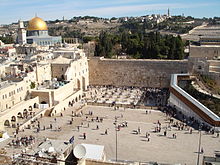
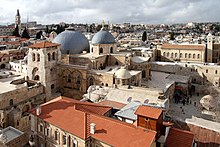

The Middle East lies at the juncture of
Prior to the formation of civilizations, advanced cultures formed all over the Middle East during the Stone Age. The search for agricultural lands by agriculturalists, and pastoral lands by herdsmen meant different migrations took place within the region and shaped its ethnic and demographic makeup.
The Middle East is widely and most famously known as the
From the 4th century CE onwards, the Middle East became the center of the two main powers at the time, the
The modern Middle East began after
In the 20th century, the region's significant stocks of
During the Cold War, the Middle East was a theater of ideological struggle between the two superpowers and their allies:
Demographics
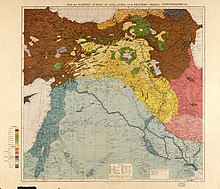
Ethnic groups
Migration
"Migration has always provided an important vent for labor market pressures in the Middle East. For the period between the 1970s and 1990s, the Arab states of the Persian Gulf in particular provided a rich source of employment for workers from Egypt, Yemen and the countries of the Levant, while Europe had attracted young workers from North African countries due both to proximity and the legacy of colonial ties between France and the majority of North African states."[39]
According to the
Non-Arab Middle Eastern countries such as Turkey, Israel and Iran are also subject to important migration dynamics.
A fair proportion of those migrating from Arab nations are from ethnic and religious minorities facing persecution and are not necessarily ethnic Arabs, Iranians or Turks.[
Religions
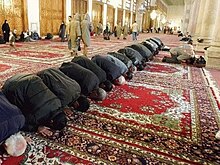
The Middle East is very diverse when it comes to
Languages
The six top languages, in terms of numbers of speakers, are
Arabic, with all its dialects, is the most widely spoken language in the Middle East, with
The third-most widely spoken language, Turkish, is largely confined to Turkey, which is also one of the region's largest and most populous countries, but it is present in areas in neighboring countries. It is a member of the Turkic languages, which have their origins in East Asia. Another Turkic language, Azerbaijani, is spoken by Azerbaijanis in Iran.

English is one of the official languages of Akrotiri and Dhekelia.[47][48] It is also commonly taught and used as a second language, especially among the middle and upper classes, in countries such as Egypt, Jordan, Iran, Kurdistan, Iraq, Qatar, Bahrain, United Arab Emirates and Kuwait.[49][50] It is also a main language in some Emirates of the United Arab Emirates. It is also spoken as native language by Jewish immigrants from Anglophone countries (UK, US, Australia) in Israel and understood widely as second language there.
Armenian speakers are to be found in the region. Georgian is spoken by the Georgian diaspora.
The largest Romanian-speaking community in the Middle East is found in Israel, where as of 1995[update] Romanian is spoken by 5% of the population.[note 3][52][53]
Bengali, Hindi and Urdu are widely spoken by migrant communities in many Middle Eastern countries, such as Saudi Arabia (where 20–25% of the population is South Asian), the United Arab Emirates (where 50–55% of the population is South Asian), and Qatar, which have large numbers of Pakistani, Bangladeshi and Indian immigrants.
Economy
This section needs to be updated. (December 2016) |
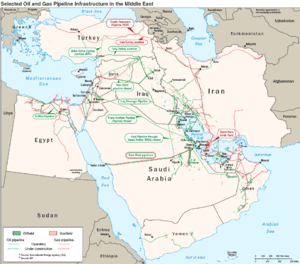
Middle Eastern economies range from being very poor (such as Gaza and Yemen) to extremely wealthy nations (such as Qatar and UAE). Overall, as of 2007[update], according to the CIA World Factbook, all nations in the Middle East are maintaining a positive rate of growth.
According to the International Monetary Fund,[54] the three largest Middle Eastern economies in nominal GDP in 2023 were Saudi Arabia ($1.062 trillion), Turkey ($1.029 trillion), and Israel ($539 billion). Regarding nominal GDP per capita, the highest ranking countries are Qatar ($83,891), Israel ($55,535), the United Arab Emirates ($49,451) and Cyprus ($33,807).[54] Turkey ($3.573 trillion), Saudi Arabia ($2.301 trillion), and Iran ($1.692 trillion) had the largest economies in terms of GDP PPP.[54] When it comes to GDP PPP per capita, the highest-ranking countries are Qatar ($124,834), the United Arab Emirates ($88,221), Saudi Arabia ($64,836), Bahrain ($60,596) and Israel ($54,997). The lowest-ranking country in the Middle East, in terms of GDP nominal per capita, is Yemen ($573).[54]
The economic structure of Middle Eastern nations are different in the sense that while some nations are heavily dependent on export of only oil and oil-related products (such as Saudi Arabia, the UAE and Kuwait), others have a highly diverse economic base (such as Cyprus, Israel, Turkey and Egypt). Industries of the Middle Eastern region include oil and oil-related products, agriculture, cotton, cattle, dairy, textiles, leather products, surgical instruments, defence equipment (guns, ammunition, tanks, submarines, fighter jets, UAVs, and missiles). Banking is also an important sector of the economies, especially in the case of UAE and Bahrain.
With the exception of Cyprus, Turkey, Egypt, Lebanon and Israel, tourism has been a relatively undeveloped area of the economy, in part because of the socially conservative nature of the region as well as political turmoil in certain regions of the Middle East. In recent years,[when?] however, countries such as the UAE, Bahrain, and Jordan have begun attracting greater numbers of tourists because of improving tourist facilities and the relaxing of tourism-related restrictive policies.[citation needed]
Unemployment is notably high in the Middle East and North Africa region, particularly among young people aged 15–29, a demographic representing 30% of the region's total population. The total regional unemployment rate in 2005, according to the International Labour Organization, was 13.2%,[55] and among youth is as high as 25%,[56] up to 37% in Morocco and 73% in Syria.[57]
Climate change
Sharp global temperature and sea level changes, shifting precipitation patterns and increased frequency of extreme weather events are some of the main impacts of climate change as identified by the Intergovernmental Panel on Climate Change (IPCC).[63] The MENA region is especially vulnerable to such impacts due to its arid and semi-arid environment, facing climatic challenges such as low rainfall, high temperatures and dry soil.[63][64] The climatic conditions that foster such challenges for MENA are projected by the IPCC to worsen throughout the 21st century.[63] If greenhouse gas emissions are not significantly reduced, part of the MENA region risks becoming uninhabitable before the year 2100.[65][66][67]
Climate change is expected to put significant strain on already scarce water and agricultural resources within the MENA region, threatening the national security and political stability of all included countries.[68] Over 60 percent of the region's population lives in high and very high water-stressed areas compared to the global average of 35 percent.[69] This has prompted some MENA countries to engage with the issue of climate change on an international level through environmental accords such as the Paris Agreement. Law and policy are also being established on a national level amongst MENA countries, with a focus on the development of renewable energies.[70]Gallery
-
Abu Dhabi – United Arab Emirates
-
Amman – Jordan
-
Ankara – Turkey
-
Beirut – Lebanon
-
Cairo – Egypt
-
Damascus – Syria
-
Doha – Qatar
-
Dubai – United Arab Emirates
-
Istanbul – Turkey
-
Jerusalem – Israel & Palestine
-
Kuwait City – Kuwait
-
Manama – Bahrain
-
Muscat– Oman
-
Nicosia – Cyprus
-
Ramallah – Palestine
-
Riyadh – Saudi Arabia
-
Sana'a– Yemen
-
Tehran – Iran
-
Tel Aviv – Israel
-
Hebron — Palestine
See also
- Cinema of the Middle East – Filmmaking in the Middle East
- Etiquette in the Middle East
- MENA– Geographic region
- Mental health in the Middle East
- Middle East Studies Association of North America– Learned society
- Middle Eastern cuisine – Regional cuisine
- Middle Eastern music – Music of the Middle Eastern region
- Orientalism – Imitation or depiction of Eastern culture
- Russia and the Middle East – Relationships between
- State feminism § Middle East
- Timeline of Middle Eastern history
Notes
- South Azerbaijani: اوْرتاشرق; Turkish: Orta Doğu.
- ^ In Italian, the expression "Vicino Oriente" (Near East) was also widely used to refer to Turkey, and Estremo Oriente (Far East or Extreme East) to refer to all of Asia east of Middle East
- ^ According to the 1993 Statistical Abstract of Israel there were 250,000 Romanian speakers in Israel, at a population of 5,548,523 (census 1995).
References
- ^ Population 1971–2010 (pdf Archived 6 January 2012 at the Wayback Machine p. 89) IEA (OECD/ World Bank) (original population ref OECD/ World Bank e.g. in IEA Key World Energy Statistics 2010 p. 57)
- ^ a b Khraish, Louay (16 July 2021). "Don't Call Me Middle Eastern". Raseef 22.
- ^ a b Hanafi, Hassan (1998). "The Middle East, in whose world? (Primary Reflections)". Oslo: Nordic Society for Middle Eastern Studies (The fourth Nordic conference on Middle Eastern Studies: The Middle East in globalizing world Oslo, 13–16 August 1998). Archived from the original on 8 October 2006.
- ISBN 978-0-8131-3672-1p. xi.
- ISBN 978-0-16-087640-0p. 177
- ISBN 978-0-8108-6302-6p. xxxi.
- ISBN 978-1446289761.
The Middle East is the cradle of the three monotheistic faiths of Judaism, Christianity and Islam.
- ISBN 978-1-59884-362-0. Archivedfrom the original on 24 April 2016. Retrieved 26 May 2014.
- ^ Beaumont, Blake & Wagstaff 1988, p. 16.
- .
- ^ Lewis, Bernard (1965). The Middle East and the West. p. 9.
- ISBN 978-0-8050-0857-9.
- ^ Melman, Billie (November 2002), Companion to Travel Writing, Collections Online, vol. 6 The Middle East/Arabia, Cambridge, archived from the original on 25 July 2011, retrieved 8 January 2006.
- ISBN 0-02-923843-9pp. 12–13.
- ^ Laciner, Sedat. "Is There a Place Called 'the Middle East'? Archived 2007-02-20 at the Wayback Machine", The Journal of Turkish Weekly, 2 June 2006. Retrieved 10 January 2007.
- ^ Adelson 1995, pp. 22–23.
- ^ Adelson 1995, p. 24.
- ^ Adelson 1995, p. 26.
- ^ S2CID 157454140.
- ^ a b "How the Middle East was invented". The Washington Post.
- ^ a b "Where Is the Middle East? | Center for Middle East and Islamic Studies".
- ISBN 978-0-8133-8221-0.
- S2CID 154611116.
- ^ Clyde, Paul Hibbert, and Burton F. Beers. The Far East: A History of Western Impacts and Eastern Responses, 1830-1975 (1975). online
- ^ Norman, Henry. The Peoples and Politics of the Far East: Travels and studies in the British, French, Spanish and Portuguese colonies, Siberia, China, Japan, Korea, Siam and Malaya (1904) online
- ^ "'Near East' is Mideast, Washington Explains". The New York Times. 14 August 1958. Archived from the original on 15 October 2009. Retrieved 25 January 2009.(subscription required)
- ^ Shohat, Ella. "Redrawing American Cartographies of Asia". City University of New York. Archived from the original on 12 March 2007. Retrieved 12 January 2007.
- ISBN 0-465-00488-1p. 156
- ^ Anderson, Ewan W.; William Bayne Fisher (2000). The Middle East: Geography and Geopolitics. Routledge. pp. 12–13.
- ^ a b c "Report for Selected Countries and Subjects". IMF. Retrieved 12 October 2023.
- ^ Novikova, Gayane (December 2000). "Armenia and the Middle East" (PDF). Middle East Review of International Affairs. Archived (PDF) from the original on 21 August 2014. Retrieved 14 August 2014.
- ^ Haeri, Safa (3 March 2004). "Concocting a 'Greater Middle East' brew". Asia Times. Archived from the original on 7 April 2004. Retrieved 21 August 2008.
- ^ Ottaway, Marina & Carothers, Thomas (29 March 2004), The Greater Middle East Initiative: Off to a False Start Archived 12 March 2009 at the Wayback Machine, Policy Brief, Carnegie Endowment for International Peace, 29, pp. 1–7
- ^ Middle East Archived 15 April 2016 at the Wayback Machine What Is The Middle East And What Countries Are Part of It? worldatlas.com. Retrieved 16 April 2016.
- ^ "The World's First Temple". Archaeology magazine. November–December 2008. p. 23.
- ISBN 0-299-09140-6.
- ^ Goldschmidt (1999), p. 8
- ^ Louise, Fawcett. International Relations of the Middle East. (Oxford University Press, New York, 2005)
- hdl:10822/1042998. Archivedfrom the original on 3 April 2017.
- ^ "IOM Intra regional labour mobility in Arab region Facts and Figures (English)" (PDF). Archived (PDF) from the original on 30 April 2011. Retrieved 31 October 2012.
- ISBN 978-1838609344.
Although the Christians of Iran, unlike their Iraqi brothers, were not called up for military service in the Iran–Iraq War ... was so radical that a genuine exodus took place – more than half the 250,000 Christians left Iran after 1979.
- ISBN 978-0857727886.
- ISBN 978-1538124185.
The Middle East still stands at the heart of the Christian world. After all, it is the birthplace, and the death place, of Christ, and the cradle of the Christian tradition.
- ISBN 978-1351510721.
Christian communities and individuals have played a vital role in the Middle East, the cradle of Christianity as of other religions.
- ISBN 1860641709.
- ISBN 978-0429962004.
Worldwide, they number 1 million or so, with about 45 to 50 percent in Syria, 35 to 40 percent in Lebanon, and less than 10 percent in Israel. Recently there has been a growing Druze diaspora.
- ^ "Europe :: Akrotiri – The World Factbook – Central Intelligence Agency". CIA. 25 October 2021.
- ^ "Europe :: Dhekelia – The World Factbook – Central Intelligence Agency". CIA. 25 October 2021.
- ^ "World Factbook – Jordan". 20 October 2021.
- ^ "Kuwait". Central Intelligence Agency. 19 October 2021 – via CIA.gov.
- ISBN 9780275973209.
- ^ "Reports of about 300,000 Jews that left the country after WW2". Eurojewcong.org. Archived from the original on 13 August 2010. Retrieved 7 July 2010.
- ^ "Evenimentul Zilei". Evz.ro. Archived from the original on 24 December 2007. Retrieved 7 July 2010.
- ^ a b c d International Monetary Fund. "World Economic Outlook Database, April 2023". International Monetary Fund.
- ^ "Unemployment Rates Are Highest in the Middle East". Progressive Policy Institute. 30 August 2006. Archived from the original on 14 July 2010. Retrieved 31 July 2008.
- ^ Navtej Dhillon; Tarek Yousef (2007). "Inclusion: Meeting the 100 Million Youth Challenge". Shabab Inclusion. Archived from the original on 9 November 2008.
- ^ Hilary Silver (12 December 2007). "Social Exclusion: Comparative Analysis of Europe and Middle East Youth". Middle East Youth Initiative Working Paper. Shabab Inclusion. Archived from the original on 20 August 2008. Retrieved 31 July 2008.
- ^ "CO2 Emissions". Global Carbon Atlas. Archived from the original on Oct 11, 2020. Retrieved 2020-04-10.
- ^ "Population, total – Middle East & North Africa, World". World Bank Open Data. Retrieved 2020-04-11.
- (PDF) from the original on Jun 14, 2021 – via Surrey Research Insight Open Access.
- ISSN 0360-5442.
- ISSN 2211-467X.
- ^ a b c IPCC, 2014: Climate Change 2014: Synthesis Report. Contribution of Working Groups I, II and III to the Fifth Assessment Report of the Intergovernmental Panel on Climate Change [Core Writing Team, R.K. Pachauri and L.A. Meyer (eds.)]. IPCC, Geneva, Switzerland, 151 pp.
- ISBN 9781781950258.
- ^ Broom, Douglas (5 April 2019). "How the Middle East is suffering on the front lines of climate change". World Economic Forum. Retrieved 4 February 2020.
- ^ Gornall, Jonathan (24 April 2019). "With climate change, life in the Gulf could become impossible". Euroactive. Retrieved 4 February 2020.
- ISSN 1758-678X.
- S2CID 134523218.
- PMID 35729894.
- ISBN 978-3-642-28625-4
Sources
- Adelson, Roger (1995). London and the Invention of the Middle East: Money, Power, and War, 1902–1922. Yale University Press. ISBN 978-0-300-06094-2.
- Beaumont, Peter; Blake, Gerald H; Wagstaff, J. Malcolm (1988). The Middle East: A Geographical Study. David Fulton. ISBN 978-0-470-21040-6.
Further reading
- Anderson, R; Seibert, R; Wagner, J. (2006). Politics and Change in the Middle East (8th ed.). Prentice-Hall.
- Barzilai, Gad; ISBN 978-0-415-08002-6.
- Barzilai, Gad (1996). Wars, Internal Conflicts and Political Order. State University of New York Press. ISBN 978-0-7914-2943-3.
- Bishku, Michael B. (2015). "Is the South Caucasus Region a Part of the Middle East?". Journal of Third World Studies. 32 (1): 83–102. JSTOR 45178576.
- Cleveland, William L., and Martin Bunton. A History Of The Modern Middle East (6th ed. 2018 4th ed. online
- Cressey, George B. (1960). Crossroads: Land and Life in Southwest Asia. Chicago, IL: J.B. Lippincott Co. xiv, 593 pp. ill. with maps and b&w photos.
- Fischbach, ed. Michael R. Biographical encyclopedia of the modern Middle East and North Africa (Gale Group, 2008).
- Freedman, Robert O. (1991). The Middle East from the Iran-Contra Affair to the Intifada, in series, Contemporary Issues in the Middle East. 1st ed. Syracuse, NY: Syracuse University Press. x, 441 pp. ISBN 0-8156-2502-2pbk.
- Goldschmidt, Arthur Jr (1999). A Concise History of the Middle East. Westview Press. ISBN 978-0-8133-0471-7.
- Halpern, Manfred. Politics of Social Change: In the Middle East and North Africa (Princeton University Press, 2015).
- Ismael, Jacqueline S., Tareq Y. Ismael, and Glenn Perry. Government and politics of the contemporary Middle East: Continuity and change (Routledge, 2015).
- Lynch, Marc, ed. The Arab Uprisings Explained: New Contentious Politics in the Middle East (Columbia University Press, 2014). p. 352.
- Palmer, Michael A. (1992). Guardians of the Persian Gulf: A History of America's Expanding Role in the Persian Gulf, 1833–1992. New York: The Free Press. ISBN 978-0-02-923843-1.
- Reich, Bernard. Political leaders of the contemporary Middle East and North Africa: a biographical dictionary (Greenwood Publishing Group, 1990).
- Vasiliev, Alexey. Russia's Middle East Policy: From Lenin to Putin (Routledge, 2018).
External links
- "Middle East – Articles by Region" Archived 9 February 2014 at the Wayback Machine – Council on Foreign Relations: "A Resource for Nonpartisan Research and Analysis"
- "Middle East – Interactive Crisis Guide" Archived 30 November 2009 at the Wayback Machine – Council on Foreign Relations: "A Resource for Nonpartisan Research and Analysis"
- Middle East Department University of Chicago Library
- Middle East Business Intelligence since 1957: "The leading information source on business in the Middle East" – meed.com
- Carboun – advocacy for sustainability and environmental conservation in the Middle East
- Middle East at Curlie
- Middle East News from Yahoo! News
- Middle East Business, Financial & Industry News – ArabianBusiness.com

